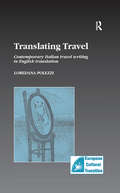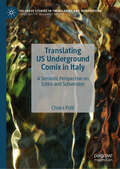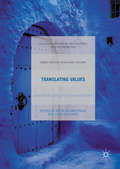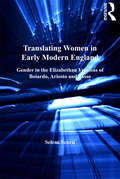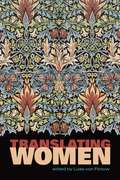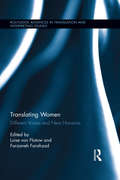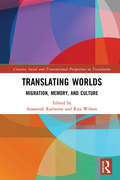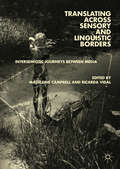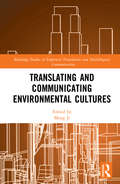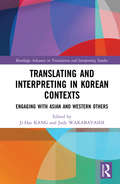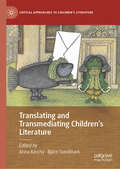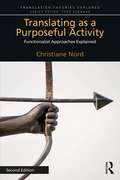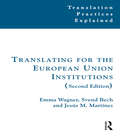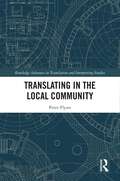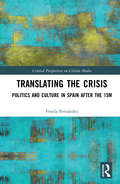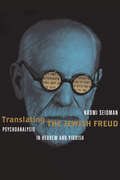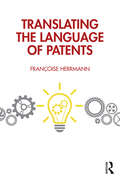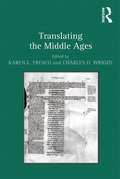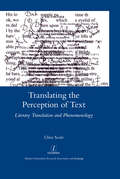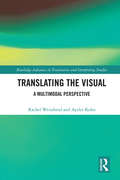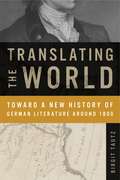- Table View
- List View
Translating Travel: Contemporary Italian Travel Writing in English Translation (Studies in European Cultural Transition #12)
by Loredana PolezziTranslating Travel examines the relationship between travel writing and translation, asking what happens when books travel beyond the narrow confines of one genre, one literary system and one culture. The volume takes as its starting point the marginal position of contemporary Italian travel writing in the Italian literary system, and proposes a comparative reading of originals and translations designed to highlight the varying reception of texts in different cultures. Two main themes in the book are the affinity between the representations produced by travel and the practices of translation, and the complex links between travel writing and genres such as ethnography, journalism, autobiography and fiction. Individual chapters are devoted to Italian travellers' accounts of Tibet and their English translations; the hybridization of journalism and travel writing in the works of Oriana Fallaci; Italo Calvino's sublimation of travel writing in the stylized fiction of Le città invisibili; and the complex network of literary references which marked the reception of Claudio Magris's Danubio in different cultures.
Translating US Underground Comix in Italy: A Semiotic Perspective on Satire and Subversion (Palgrave Studies in Translating and Interpreting)
by Chiara PolliThis book analyses 1960s-1970s US underground comix, a &‘counterculture&’ art form that satirised mainstream values and taboos. The author observes comix in their multimodal components in the original English-language versions and in their Italian translations by unpacking the several layers of verbal and visual meaning-making. She then goes on to scrutinise translation and resemiotisation processes, including modifications, mitigations, and omissions, encompassing socio-historical and cross-cultural perspectives. The book argues that translation, meant to bridge two (counter-)cultures, served as a gatekeeper instead, zooming in on certain themes, while inadvertently overlooking or purposefully manipulating others, with an outcome close to censorship. The volume is divided into nine chapters. Chapter 1 summarises the aims and scope of the volume. Chapter 2 introduces comix as a subversive phenomenon. Chapter 3 illustrates the theoretical and methodological framework of analysis, based on semiotics and multimodality. Chapter 4 presents the corpus of Italian translations, which includes works translated between 1968 and 2022 by both mainstream and alternative publishers. In Chapters 5-8, Italian translations of comix dealing with such controversial themes as sex, drugs, political struggle, and religion are analysed, with qualitative observations of several translations of the same comix provided to highlight changing times, cultural frames, ideologies, editorial policies, and target audiences. Chapter 9 discusses the findings of these observations and maintains that, as a recursive translation strategy, seditious contents were mitigated, trivialised, or censored by adopting light-hearted frames so that potentially problematic contents could be left out. With its linguistic, translational, and intercultural analyses, this volume will be useful for researchers of linguistics, semiotics, translation, and comics studies.
Translating Values
by John Gillespie Piotr BlumczynskiThis collection explores the central importance of values and evaluative concepts in cross-cultural translational encounters. Written by a group of international scholars from a diverse range of linguistic and cultural backgrounds, the chapters in this book consider what it means to translate cultures by examining core values and their relationship to key evaluative concepts (such as authenticity, clarity, home, honour, or justice) and how they influence the complex multidimensional process of translation. This book will be of interest to academics studying cross-cultural and inter-linguistic interactions, to translators and interpreters, students of translation and of modern languages, and all those dealing with multilingual and multicultural settings.
Translating War: Literature and Memory in France and Britain from the 1940s to the 1960s (Palgrave Studies in Languages at War)
by Angela KershawThis book examines the role played by the international circulation of literature in constructing cultural memories of the Second World War. War writing has rarely been read from the point of view of translation even though war is by definition a multilingual event, and knowledge of the Second World War and the Holocaust is mediated through translated texts. Here, the author opens up this field of research through analysis of several important works of French war fiction and their English translations. The book examines the wartime publishing structures which facilitated literary exchanges across national borders, the strategies adopted by translators of war fiction, the relationships between translated war fiction and dominant national memories of the war, and questions of multilingualism in war writing. In doing so, it sheds new light on the political and ethical questions that arise when the trauma of war is represented in fiction and through translation. This engaging work will appeal to students and scholars of translation, cultural memory, war fiction and Holocaust writing.
Translating Women in Early Modern England: Gender in the Elizabethan Versions of Boiardo, Ariosto and Tasso (Anglo-Italian Renaissance Studies)
by Selene ScarsiSituating itself in a long tradition of studies of Anglo-Italian literary relations in the Renaissance, this book consists of an analysis of the representation of women in the extant Elizabethan translations of the three major Italian Renaissance epic poems (Matteo Maria Boiardo's Orlando Innamorato, Ludovico Ariosto's Orlando Furioso and Torquato Tasso's Gerusalemme Liberata), as well as of the influence of these works on Elizabethan Literature in general, in the form of creative imitation on the part of poets such as Edmund Spenser, Peter Beverley, William Shakespeare and Samuel Daniel, and of prose writers such as George Whetstone and George Gascoigne. The study emphasises the importance of European writers' influence on English Renaissance Literature and raises questions pertaining to the true essence of translation, adaptation and creative imitation, with a specific emphasis on gender issues. Its originality lies in its exhaustiveness, as well as in its focus on the epics' female figures, both as a source of major modifications and as an evident point of interest for the Italian works' 'translatorship'.
Translating Women: Different Voices And New Horizons (Perspectives on Translation)
by Luise Von FlotowFeminist theory has been widely translated, influencing the humanities and social sciences in many languages and cultures. However, these theories have not made as much of an impact on the discipline that made their dissemination possible: many translators and translation scholars still remain unaware of the practices, purposes and possibilities of gender in translation. Translating Women revives the exploration of gender in translation begun in the 1990s by Susanne de Lotbinière-Harwood’s Re-belle et infidèle/The Body Bilingual (1992), Sherry Simon’s Gender in Translation (1996), and Luise von Flotow’s Translation and Gender (1997). Translating Women complements those seminal texts by providing a wide variety of examples of how feminist theory can inform the study and practice of translation. Looking at such diverse topics as North American chick lit and medieval Arabic, Translating Women explores women in translation in many contexts, whether they are women translators, women authors, or women characters. Together the contributors show that feminist theory can apply to translation in many new and unexplored ways and that it deserves the full attention of the discipline that helped it become internationally influential.
Translating Women: Different Voices and New Horizons (Routledge Advances in Translation and Interpreting Studies)
by Luise Von Flotow Farzaneh FarahzadThis book focuses on women and translation in cultures 'across other horizons' well beyond the European or Anglo-American centres. Drawing on transnational feminist connections, its editors have assembled work from four continents and included articles from Morocco, Mexico, Sri Lanka, Turkey, China, Saudi Arabia, Columbia and beyond. Thirteen different chapters explore questions around women's roles in translation: as authors, or translators, or theoreticians. In doing so, they open new territories for studies in the area of 'gender and translation' and stimulate academic work on questions in this field around the world. The articles examine the impact of 'Western' feminism when translated to other cultures; they describe translation projects devised to import and make meaningful feminist texts from other places; they engage with the politics of publishing translations by women authors in other cultures, and the role of women translators play in developing new ideas. The diverse approaches to questions around women and translation developed in this collection speak to the volume of unexplored material that has yet to be addressed in this field.
Translating Worlds: Migration, Memory, and Culture (Creative, Social and Transnational Perspectives on Translation)
by Susannah RadstoneThis international and interdisciplinary volume explores the relations between translation, migration, and memory. It brings together humanities researchers from a range of disciplines including history, museum studies, memory studies, translation studies, and literary, cultural, and media studies to examine memory and migration through the interconnecting lens of translation. The innovatory perspective adopted by Translating Worlds understands translation’s explanatory reach as extending beyond the comprehension of one language by another to encompass those complex and multi-layered processes of parsing by means of which the unfamiliar and the familiar, the old home and the new are brought into conversation and connection. Themes discussed include: How memories of lost homes act as aids or hindrances to homemaking in new worlds. How cultural memories are translated in new cultural contexts. Migration, affect, memory, and translation. Migration, language, and transcultural memory. Migration, traumatic memory, and translation.
Translating across Sensory and Linguistic Borders: Intersemiotic Journeys between Media
by Ricarda Vidal Madeleine CampbellThis book analyses intersemiotic translation, where the translator works across sign systems and cultural boundaries. Challenging Roman Jakobson’s seminal definitions, it examines how a poem may be expressed as dance, a short story as an olfactory experience, or a film as a painting. This emergent process opens up a myriad of synaesthetic possibilities for both translator and target audience to experience form and sense beyond the limitations of words. The editors draw together theoretical and creative contributions from translators, artists, performers, academics and curators who have explored intersemiotic translation in their practice. The contributions offer a practitioner’s perspective on this rapidly evolving, interdisciplinary field which spans semiotics, cognitive poetics, psychoanalysis and transformative learning theory. The book underlines the intermedial and multimodal nature of perception and expression, where semiotic boundaries are considered fluid and heuristic rather than ontological. It will be of particular interest to practitioners, scholars and students of modern foreign languages, linguistics, literary and cultural studies, interdisciplinary humanities, visual arts, theatre and the performing arts.
Translating and Communicating Environmental Cultures (Routledge Studies in Empirical Translation and Multilingual Communication)
by Meng JiEnvironmental translation studies has gained momentum in recent years as a new area of research underscored by the need to communicate environmental concerns and studies across cultures. The dissemination of translated materials on environmental protection and sustainable development has played an instrumental role in transforming local culture and societies. This edited book represents an important effort to advance environmental studies by introducing the latest research on environmental translation and cross-cultural communication. Part I of the book presents the newest research on multilingual environmental resource development based at leading research institutes in Europe, Latin America, North America, and the Asia-Pacific. Part II offers original, thought-provoking linguistic, textual and cultural analyses of environmental issues in genres as diverse as literature, nature-based tourism promotion, environmental marketing, environmental documentary, and children’s reading. Chapters in this book represent original research authored by established and mid-career academics in translation studies, computer science, linguistics, and environmental studies around the world. The collection provides engaging reading and references on environmental translation and communication to a wide audience across academia.
Translating and Interpreting in Australia and New Zealand: Distance and Diversity (Routledge Advances in Translation and Interpreting Studies)
by Judy Wakabayashi and Minako O’HaganThis volume explores Australian and New Zealand experiences of translation and interpreting (T&I), with a special focus on the formative impact of geocultural contexts. Through the critical lenses of practitioners, scholars and related professionals working in and on these two countries, the contributors seek a better understanding of T&I practices and discourses in this richly multilingual and multicultural region. Building on recent work in translation and interpreting studies that extends attention to sites outside of Europe and the Americas, this volume considers the geocultural and geopolitical factors that have helped shape T&I in these Pacific neighbours, especially how the practices and conceptualization of T&I have been closely tied with immigration. Contributors examine the significant role T&I plays in everyday communication across varied sectors, including education, health, business, and legal contexts, as well as in crisis situations, cultural and creative settings, and initiatives to revitalize Indigenous languages. The book also looks to the broader implications beyond the Australian and New Zealand translationscape, making it of relevance to T&I scholars elsewhere, as well as those with an interest in Indigenous studies and minority languages.
Translating and Interpreting in Korean Contexts: Engaging with Asian and Western Others (Routledge Advances in Translation and Interpreting Studies)
by Judy Wakabayashi Ji-Hae KangThe focus of this volume is on how the people of the Korean Peninsula—historically an important part of the Sinocentric world in East Asia and today a vital economic and strategic site—have negotiated oral and written interactions with their Asian neighbors and Europeans in the past and present through the mediation of translators and interpreters. These encounters have been shaped by political, social, and cultural factors, including the shared use of the Chinese writing system in East Asia for many centuries, attitudes toward other Asians and Westerners, and perceptions of Korean identity in relation to these Others. After exploring aspects of historical interactions, the volume addresses how the role and practice of translation and interpreting have recently evolved as a result of the development of digital technology, an increase in the number of immigrants, and changes in political and cultural dynamics in the region. It covers a range of historical and contemporary aspects, genres, and venues that extend beyond the common yet restrictive focus on literary translation and includes discussions of translator training and academic studies of translation and interpreting in Korea.
Translating and Transmediating Children’s Literature (Critical Approaches to Children's Literature)
by Björn Sundmark Anna KérchyFrom Struwwelpeter to Peter Rabbit, from Alice to Bilbo—this collection of essays shows how the classics of children’s literature have been transformed across languages, genres, and diverse media forms. This book argues that translation regularly involves transmediation—the telling of a story across media and vice versa—and that transmediation is a specific form of translation. Beyond the classic examples, the book also takes the reader on a worldwide tour, and examines, among other things, the role of Soviet science fiction in North Korea, the ethical uses of Lego Star Wars in a Brazilian context, and the history of Latin translation in children’s literature. Bringing together scholars from more than a dozen countries and language backgrounds, these cross-disciplinary essays focus on regularly overlooked transmediation practices and terminology, such as book cover art, trans-sensory storytelling, écart, enfreakment, foreignizing domestication, and intra-cultural transformation.
Translating as a Purposeful Activity: Functionalist Approaches Explained (Translation Theories Explored)
by Christiane NordThis bestselling text is a comprehensive overview of functionalist approaches to translation in English. Christiane Nord, one of the leading figures in translation studies, explains the complexities of theories and terms in simple language with numerous examples. Covering how the theories developed, illustrations of the main ideas, and specific applications to translator training, literary translation, interpreting and ethics, Translating as a Purposeful Activity concludes with a concise review of both criticisms and perspectives for the future. Now with a Foreword by Georges Bastin and a new chapter covering the recent developments and elaborations of the theory, this is an essential text for students of translation studies and for translator training.
Translating for Museums, Galleries and Heritage Sites (Translation Practices Explained)
by Robert NeatherIn any museum, gallery, or heritage site that wishes to engage with foreign-language visitors, translation is essential. Providing texts in foreign languages – whether for international visitors from different language cultures or for heritage speakers of local minority languages – is centrally important in enabling these visitors to make sense of what they see displayed. Yet despite this awareness, and a growing body of research in the field, there has hitherto been little available in the way of practical training in this area of translation. This book aims to help fill that need.Translating for Museums, Galleries and Heritage Sites focuses on the translation of interpretive and information texts, particularly in the museum context. After an initial introduction and an overview of key concepts in both museums and translation, it looks at three broad groupings of texts from the museum text system: fixed labels and wall panels, leaflets and other portable learning resources, and catalogues and guides, including a section on websites. It concludes with a call to place translation centre stage in museum, gallery, and heritage practice. The book will be of use as a coursebook for students at both undergraduate and postgraduate levels, and for practitioners in the sector, and is designed to be suitable for both individual and class-based learning.
Translating for the European Union (Translation Practices Explained)
by Emma Wagner Svend Bech Jesús M. MartínezThe institutions of the European Union employ hundreds of translators. Why? What do they do? What sort of translation problems do they have to tackle? Has the language policy of the European Union been affected by the recent inclusion of new Member States? This book answers all those questions. Written by three experienced translators from the European Commission, it aims to help general readers, translation students and freelance translators to understand the European Union institutions and their work. Although it deals with written rather than spoken translation, much of the information it gives will be of interest to interpreters too. This second edition has been updated to reflect the new composition of the EU and changes to recruitment procedures.
Translating for the European Union Institutions (Translation Practices Explained)
by Emma Wagner Svend Bech Jesús M. MartínezThe institutions of the European Union employ hundreds of translators. Why? What do they do? What sort of translation problems do they have to tackle? Has the language policy of the European Union been affected by the recent inclusion of new Member States? This book answers all those questions. Written by three experienced translators from the European Commission, it aims to help general readers, translation students and freelance translators to understand the European Union institutions and their work. Although it deals with written rather than spoken translation, much of the information it gives will be of interest to interpreters too. This second edition has been updated to reflect the new composition of the EU and changes to recruitment procedures.
Translating in the Local Community (Routledge Advances in Translation and Interpreting Studies)
by Peter FlynnThis volume showcases different forms of natural and non-professional translation and interpreting at work at multilingual sites in a single city, shedding new light on our understanding of the intersection of city, migration and translation. Flynn builds on work in translation studies, sociolinguistics, linguistic ethnography and anthropology to offer a translational perspective on scholarship on multilingualism and translation, focusing on examples from the superdiverse city of Ghent in Belgium. Each chapter comprises a different multilingual site, ranging from schools to eateries to public transport, and unpacks specific dimensions of translation practices within and against constantly shifting multilingual settings. The book also reflects on socio-political factors and methodological considerations of concern when undertaking such an approach. Taken together, the chapters seek to provide a composite picture of translation in a multilingual city, demonstrating how tracing physical, linguistic and social trajectories of movement in these contexts can deepen our understanding of the contemporary dynamics of multilingualism and natural translation and of translanguaging, more broadly. This book will be of interest to students and scholars in translation and interpreting studies, sociolinguistics, multilingualism, linguistic anthropology and migration studies.
Translating the Crisis: Politics and Culture in Spain after the 15M (Critical Perspectives on Citizen Media)
by Fruela FernándezTranslating the Crisis discusses the multiple translation practices that shaped the 15M movement, also known as the indignados (‘outraged’), a series of mass demonstrations and occupations of squares that took place across Spain in 2011 and which played a central role in the recent global wave of popular protest. Through a study of the movement's cultural and intellectual impact, as well as some of its main political evolutions (namely Podemos and Barcelona en Comú), Fernández shows how translation has contributed to the dissemination of ideas and the expansion of political debates, produced new intellectual and political figures, and provided support to political projects. Drawing on fieldwork, interviews, and a large repertoire of sources in various languages, this monograph provides an in-depth study of the role of translation in the renewal of activist language, the development of political platforms, and the creation of new social references, while also presenting a critical perspective on its limitations and shortcomings. Combining first-hand experience of the Spanish reality with a keen transnational awareness, Fernández offers a nuanced, present-day perspective on the political events taking place in Spain and connects them with wider transformations across the world. This book is invaluable for scholars and researchers in Translation Studies, Spanish Studies, Social Movement Studies, and Politics.
Translating the Jewish Freud: Psychoanalysis in Hebrew and Yiddish (Stanford Studies in Jewish History and Culture)
by Naomi SeidmanThere is an academic cottage industry on the "Jewish Freud," aiming to detect Jewish influences on Freud, his own feelings about being Jewish, and suppressed traces of Jewishness in his thought. This book takes a different approach, turning its gaze not on Freud but rather on those who seek out his concealed Jewishness. What is it that propels the scholarly aim to show Freud in a Jewish light? Naomi Seidman explores attempts to "touch" Freud (and other famous Jews) through Jewish languages, seeking out his Hebrew name or evidence that he knew some Yiddish. Tracing a history of this drive to bring Freud into Jewish range, Seidman also charts Freud's responses to (and jokes about) this desire. More specifically, she reads the reception and translation of Freud in Hebrew and Yiddish as instances of the desire to touch, feel, "rescue," and connect with the famous Professor from Vienna.
Translating the Language of Patents
by Françoise HerrmannThis book is a guide to translating the language of patents in view of avoiding costly translation errors. Errors that might hinder the examination process for granting patents, or that might make patents undefendable in a context of litigation.The 42 sections of this book each identify different provisions of the law for their relevance to translation. These provisions govern language uses, right down to the use of punctuation. Each of the sections present findings, both in terms of the relevant provisions identified, and their specific significance to translation. Exemplified translations focus on French and English, but when there is a consensus across Intellectual property systems, multilingual parallelism is highlighted. Wherever relevant, provisions of specific rules and regulations are presented and exemplified in the three official languages of the European Patent Office (EPO), English, French, and German and the three official languages of the United Nations World Intellectual Property Organization (WIPO), English, French, and Spanish.Written by an experienced teacher, patent translator, and author of the blog, Patents on the Soles of Your Shoes, this is a rigorously researched, authoritative, and comprehensive guide for all professional translators working on patents, and for students and translators working in legal translation. Accompanying e-resources are available on the Routledge Translation studies portal (routledgetranslationstudiesportal.com) including information on how to use this book in courses.
Translating the Middle Ages
by Karen L. FrescoDrawing on approaches from literary studies, history, linguistics, and art history, and ranging from Late Antiquity to the sixteenth century, this collection views 'translation' broadly as the adaptation and transmission of cultural inheritance. The essays explore translation in a variety of sources from manuscript to print culture and the creation of lexical databases. Several essays look at the practice of textual translation across languages, including the vernacularization of Latin literature in England, France, and Italy; the translation of Greek and Hebrew scientific terms into Arabic; and the use of Hebrew terms in anti-Jewish and anti-Muslim polemics. Other essays examine medieval translators' views and performance of translation, looking at Lydgate's translation of Greek myths through mental images rendered through rhetorical figures or at how printing transformed the rhetoric of intervernacular translation of chivalric romances. This collection also demonstrates translation as a key element in the construction of cultural and political identity in the Fet des Romains and Chester Whitsun Plays, and in the papacy's efforts to compete with Byzantium by controlling the translation of Greek writings.
Translating the Perception of Text: Literary Translation and Phenomenology
by Clive ScottTranslation often proceeds as if languages already existed, as if the task of the translator were to make an appropriate selection from available resources. Clive Scott challenges this tacit assumption. If the translator is to do justice to himself/herself as a reader, if the translator is to become the creative writer of his/her reading, then the language of translation must be equal to the translators perceptual experience of, and bodily responses to, source texts. Each renewal of perceptual and physiological contact with a text involves a renewal of the ways we think language and use our expressive faculties (listening, speaking, writing). Phenomenology and particularly the phenomenology of Merleau-Ponty underpins this new approach to translation. The task of the translator is tirelessly to develop new translational languages, ever to move beyond the bilingual into the multilingual, and always to remember that language is as much an active instrument of perception as an object of perception. Clive Scott is Professor Emeritus of European Literature at the University of East Anglia, and a Fellow of the British Academy.
Translating the Visual: A Multimodal Perspective (Routledge Advances in Translation and Interpreting Studies)
by Rachel Weissbrod Ayelet KohnThis book offers insights into the translation and adaptation of illustrated texts in an era in which visual texts are perceived as a dominant perceptual frame for interpreting social and cultural phenomena. Using source texts including illustrated books, comics, graphic novels and animated films, the authors analyze their translations and adaptations to address the works as multimodal entities, in which even the replacement of one component affects the entire whole. Interviews with the artists - writers, illustrators and animators - will shed more light on the observations. This volume’s unique focus on the visual mode and the impact of its replacement on the multimodal whole is a topic that has not attracted as much attention as the translation of the verbal component, and will appeal to students and researchers of translation and adaptation, popular culture, media and communication, and children’s literature alike.
Translating the World: Toward a New History of German Literature Around 1800 (Max Kade Research Institute)
by Birgit TautzIn Translating the World, Birgit Tautz provides a new narrative of German literary history in the late eighteenth and early nineteenth centuries. Departing from dominant modes of thought regarding the nexus of literary and national imagination, she examines this intersection through the lens of Germany’s emerging global networks and how they were rendered in two very different German cities: Hamburg and Weimar.German literary history has tended to employ a conceptual framework that emphasizes the nation or idealized citizenry, yet the experiences of readers in eighteenth-century German cities existed within the context of their local environments, in which daily life occurred and writers such as Lessing, Schiller, and Goethe worked. Hamburg, a flourishing literary city in the late eighteenth century, was eventually relegated to the margins of German historiography, while Weimar, then a small town with an insular worldview, would become mythologized for not only its literary history but its centrality in national German culture. By interrogating the histories of and texts associated with these cities, Tautz shows how literary styles and genres are born of local, rather than national, interaction with the world. Her examination of how texts intersect and interact reveals how they shape and transform the urban cultural landscape as they are translated and move throughout the world.A fresh, elegant exploration of literary translation, discursive shifts, and global cultural changes, Translating the World is an exciting new story of eighteenth-century German culture and its relationship to expanding global networks that will especially interest scholars of comparative literature, German studies, and literary history.
